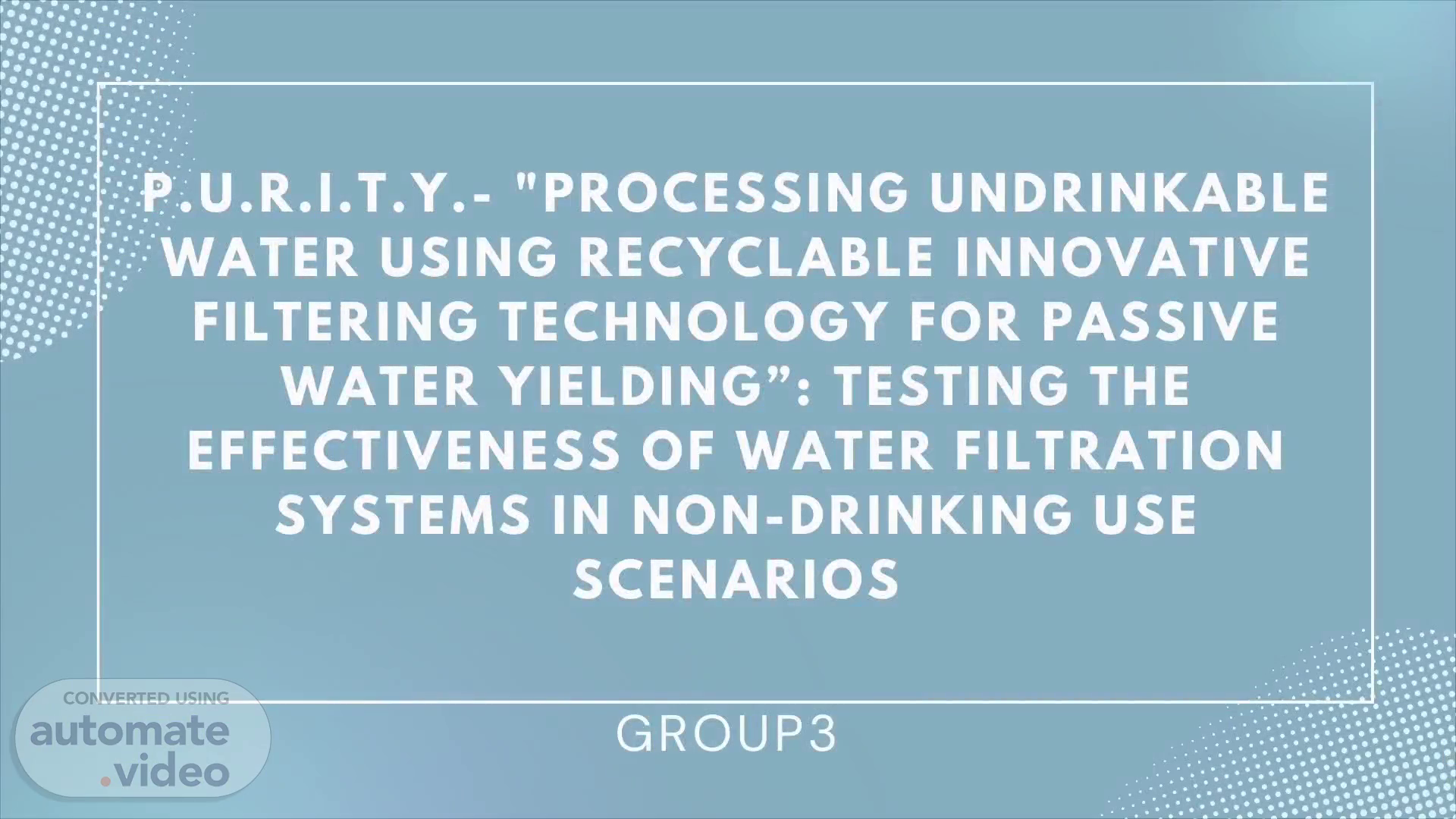Scene 1 (0s)
•.P.U.R.I.T.Y.- "PROCESSING UNDRINKABLE WATER USING RECYCLABLE INNOVATIVE FILTERING TECHNOLOGY FOR PASSIVE WATER YIELDING": TESTING THE EFFECTIVENESS OF WATER FILTRATION SYSTEMS IN NON-DRINKING USE SCENARIOS GROUP3.
Scene 2 (12s)
CONTEXT AND RATIONALE -GLOBALLY - Southeast Asia facing water resource deterioration - Urban areas implementing sustainable urban water manage ent solutions - P.U.R.I.T.Y. innovative water filter products provide clean, safe recy led water - Redu •ng environmental impact and preserving ecological balance - Widespread contamination of surface water due to antibiotics use omprehen ive studies showing concentrations ranging from <1 ng/h o hundr ds of pg/L ast Asian ountries showing more extensive concentrations..
Scene 3 (33s)
CONTEXT AND RATIONALE -GLOBALLY - India has 18% of the world's population but only 4% of its GJ ter resources. - India faces significant challenges in accessing clean water. - The country is among the most water-stressed in the world. - Anhverage American family wastes up to 180 gallons of water each week. Kitchen s•pks contribute to this issue, as they often contain food scra sand gr ase. - Mai tainingtöb system becomes more difficult with the presence of s c substa ces..
Scene 4 (54s)
CONTEXT AND RATIONALE -PHILIPPINES From a total of 101 million Filipinos, 9 million still experi nce water shortages due to inadequate, unsafe, and sustainable water sources. Rur I areas, low-income urban districts, and even Metro Manila are all ffected by sporadic and inadequate water supplies. The Phil ppines urgently require infrastructural development and comprehensive water resource management to handle this issue. - Pub •c healt conomic growth, and overall well-being are all dependent o having access to clean, safe, and sustainable water..
Scene 5 (1m 17s)
CONTEXT AND RATIONALE -PHILIPPINES - The government of the Philippines wants to provid access to improved water sources to everyone by the year 20 and yet 1 in 10 people cannot access it. - Fo sustainable water management, it is essential to create new, usable filtration technology for treating unusable waterin on-drinking situations. - Passive wa er-yielding systems aim to offer effective filt ring wit ut needing on external energy sources. They re also e vironmentally benign..
Scene 6 (1m 37s)
CONTEXT AND RATIONALE -PHILIPPINES Regional access to basic water services ranges fro 62% to 100%, which is quite unequal across the nation. - Targeted efforts and investments are necessary to ensure eqåi able access to clean and safe water for all citizens - Wast ater volumes in Metro Manila increased 32% in 2019 compared to 2010 levels, and the proportion of wastewater eated increased from 9.7% to 14.5% during the sa e time..
Scene 7 (1m 57s)
CONCEPTUAL FRAMEWORK PROCESS INPUT Data Gathering —Used sink water —Testing the bacteria (Recyclable water source) level of water —P.U.R.I.T.Y (PVC filtration —Testing the time it system) takes for the water to go through P.U.R.I.T.Y —Technique or process used by water refilling Building Process stations to disenfect and — Creating PURITY using purity the water. pvc and other materials. OUTPUT — Clean non-drinkable water suitable for washing dishes, hands, watering plants etc. —Decrease in wasted water — Made recycling of used water possible.
Scene 8 (2m 19s)
STATEMENT OF THE PROBLEM This research aimed to determine the viability of P.U.R.I.T.Y.- "Processing Undrinkable Water Using Recyclable Innovative Filtering Technology fo Passive Water Yielding"as a sustainable source of water. Especially, it pursues to answer the following questions:.
Scene 9 (2m 33s)
STATEMENT OF THE PROBLEM 1. How does the recycled water produced from P.U.R.I.T.Y. help reduce the waste-water from an average household? 2. Will P.U.R.I.T.Y. help improve the lives of people from rural areas by saving and recycling used water? 3. Does the recycled water from P.U.R.I.T.Y. present negative effects to a consumer, like: a. Ski irritations; and b. Potential diseases from bacterias?.
Scene 10 (2m 57s)
MesA PVC ST roJUCt Filtration Rings Pebbles ctivated Charcoal Granulated Fine Gravel Sand.
